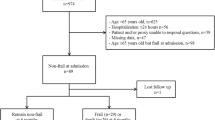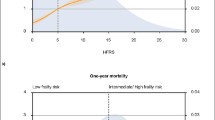Abstract
Aim
The study aimed to investigate the effects of frailty on clinical outcomes of patients in an intensive care unit (ICU).
Methods
In this prospective study, 122 patients (59 frail, 37 pre-frail and 26 robust) were included. A frailty index (FI) derived from comprehensive geriatric assessment parameters was used for the evaluation. The FI score of ≤0.25 was considered as robust, 0.25–0.40 as pre-frail and >0.40 as frail. The prognostic effects of FI were investigated and FI and APACHE II and SOFA scores, the prognostic scores using in ICU, were compared.
Results
Median age of the patients was 71 years old and 50.8 % were male. ICU mortality rate and median length of stay (LOS) were 51.6 % and 8 days (min–max: 1–148), respectively. ICU mortality was higher (69.2, 56.8 and 40.7 %, respectively, p = 0.040) and median overall survival was lower in frail group compared to pre-frail and robust subjects (23, 31 and 140 days, p = 0.013, respectively). Long term mortality over 3 and 6 months in frail patients were 80.8 and 84.6 %, respectively and significantly higher than others. Multivariate analysis showed that LOS in ICU (HR 1.067, 95 % CI 1.021–1.114), SOFA score (HR 1.272, 95 % CI 1.096–1.476) and FI (HR 39.019, 95 % CI 1.235–1232.537) were the independent correlates for ICU mortality (p = 0.004, p = 0.002 and 0.038, respectively). There was a weak but statistically significant positive correlation between APACHE II and FI scores (r = 0.190, p = 0.036).
Conclusions
FI may be used as a predictor for the evaluation of elderly patients’ clinical outcomes in ICUs.

Similar content being viewed by others
References
Halil M, Cemal Kizilarslanoglu M, Emin Kuyumcu M, Yesil Y, Cruz Jentoft AJ (2015) Cognitive aspects of frailty: mechanisms behind the link between frailty and cognitive impairment. J Nutr Health Aging 19:276–283
Knaus WA, Draper EA, Wagner DP, Zimmerman JE (1985) APACHE II: a severity of disease classification system. Crit Care Med 13:818–829
Cawthon PM, Marshall LM, Michael Y, Dam TT, Ensrud KE, Barrett-Connor E, Orwoll ES (2007) Frailty in older men: prevalence, progression, and relationship with mortality. J Am Geriatr Soc 55:1216–1223
Bouillon K, Batty GD, Hamer M, Sabia S, Shipley MJ, Britton A, Singh-Manoux A, Kivimaki M (2013) Cardiovascular disease risk scores in identifying future frailty: the Whitehall II prospective cohort study. Heart 99:737–742
Strandberg TE, Pitkälä KH, Tilvis RS (2011) Frailty in older people. European geriatric medicine 2:344–355
McDermid RC, Stelfox HT, Bagshaw SM (2011) Frailty in the critically ill: a novel concept. Crit Care 15:301
Hope AA, Gong MN, Guerra C, Wunsch H (2015) frailty before critical illness and mortality for elderly medicare beneficiaries. J Am Geriatr Soc 63:1121–1128
Fisher C, Karalapillai DK, Bailey M, Glassford NG, Bellomo R, Jones D (2015) Predicting intensive care and hospital outcome with the dalhousie clinical frailty scale: a pilot assessment. Anaesth Intensive Care 43:361–368
Bagshaw SM, Stelfox HT, Johnson JA, McDermid RC, Rolfson DB, Tsuyuki RT, Ibrahim Q, Majumdar SR (2015) Long-term association between frailty and health-related quality of life among survivors of critical illness: a prospective multicenter cohort study. Crit Care Med 43:973–982
Orsini J, Blaak C, Shamian B, Fonseca X, Salem A, Chen YL (2015) Assessing the utility of ICU admission for octogenarians. Aging Clin Exp Res. doi:10.1007/s40520-015-0462-9
Krishnan M, Beck S, Havelock W, Eeles E, Hubbard RE, Johansen A (2014) Predicting outcome after hip fracture: using a frailty index to integrate comprehensive geriatric assessment results. Age Ageing 43:122–126
Vincent JL, Moreno R, Takala J, Willatts S, De Mendonca A, Bruining H, Reinhart CK, Suter PM, Thijs LG (1996) The SOFA (sepsis-related organ failure assessment) score to describe organ dysfunction/failure. On behalf of the Working Group on Sepsis-Related Problems of the European Society of Intensive Care Medicine. Intensive Care Med 22:707–710
Le Maguet P, Roquilly A, Lasocki S, Asehnoune K, Carise E, Saint Martin M, Mimoz O, Le Gac G, Somme D, Cattenoz C, Feuillet F, Malledant Y, Seguin P (2014) Prevalence and impact of frailty on mortality in elderly ICU patients: a prospective, multicenter, observational study. Intensive Care Med 40:674–682
Bagshaw SM, Stelfox HT, McDermid RC, Rolfson DB, Tsuyuki RT, Baig N, Artiuch B, Ibrahim Q, Stollery DE, Rokosh E, Majumdar SR (2014) Association between frailty and short- and long-term outcomes among critically ill patients: a multicentre prospective cohort study. CMAJ 186:95–102
Baldwin MR, Reid MC, Westlake AA, Rowe JW, Granieri EC, Wunsch H, Dam TT, Rabinowitz D, Goldstein NE, Maurer MS, Lederer DJ (2014) The feasibility of measuring frailty to predict disability and mortality in older medical intensive care unit survivors. J Crit Care 29:401–408
Zeng A, Song X, Dong J, Mitnitski A, Liu J, Guo Z, Rockwood K (2015) Mortality in Relation to Frailty in Patients Admitted to a Specialized Geriatric Intensive Care Unit. J Gerontol Ser A Biol Sci Med Sci 70:1586–1594
Philippart F, Vesin A, Bruel C, Kpodji A, Durand-Gasselin B, Garcon P, Levy-Soussan M, Jagot JL, Calvo-Verjat N, Timsit JF, Misset B, Garrouste-Orgeas M (2013) The ETHICA study (part I): elderly’s thoughts about intensive care unit admission for life-sustaining treatments. Intensive Care Med 39:1565–1573
Heyland D, Cook D, Bagshaw SM, Garland A, Stelfox HT, Mehta S, Dodek P, Kutsogiannis J, Burns K, Muscedere J, Turgeon AF, Fowler R, Jiang X, Day AG, Canadian Critical Care Trials G, Canadian Researchers at the End of Life N (2015) The very elderly admitted to icu: a quality finish? Crit Care Med 43:1352–1360
Author information
Authors and Affiliations
Corresponding author
Ethics declarations
Conflict of interest
None.
Statement of human and animal rights
We complied of the ethical standards for human rights. The study protocol was approved by Clinical Investigation and Ethic Committee of Gazi University School of Medicine.
Informed consent
The patients were included in the study after taken informed consent from the patients or patient’s relatives if not possible to take it from the patients.
Financial disclosure
None.
Appendix
Appendix
Deficits counted | Points (max denominator 55) |
|---|---|
Motivation | Low = 1 |
Self-rated health | Excellent = 0, good = 0.25, fair = 0.5, poor/can not say = 1 |
Cognition | Dementia = 1, Mild cog. Imp. = 0.5, Delirium = 1 Agitation = 1 Delusions/hallucinations = 1 |
MMSE | 24 or less = 1, >24 = 0 |
Emotional state | Anxiety = 1 Recent bereavement = 1 Depression = 1 Fatigue = 1 |
Sleep | Poor or disrupted = 1 |
Daytime drowsiness = 1 | |
Speech | Impaired = 1 |
Hearing | Impaired = 1 |
Vision (with glasses) | Impaired = 1 |
Hemiparesis | Weak arm = 1 Weak leg = 1 |
Grip strength (on non-hemiplegic side) | Weak = 1 |
Proximal muscle strength (on non-hemiplegic side) | Weak = 1 |
Weight | Underweight = 1, Obese = 1, slightly overweight = 0 |
Weight change | Loss = 1, significant gain = 1 |
Appetite | Poor = 1, fair = 0.5, normal = 0 |
Continence | Bowels incontinent = 1 Bladder incontinent/catheter = 1 |
Medical History (scoring 1 point each) | Hypertension Asthma/Chronic obstructive lung disease Stroke/Transient ischaemic attack Angina/Myocardial infarction Heart Failure Diabetes Active cancer Alcohol excess Pressure sores Hip fracture Osteoarthritis/osteoporosis Parkinson’s disease 1st other medical problem 2nd other medical problem |
No. of medications in 24 h | 0–4 = 0, 5–9 = 1, 10–14 = 2, 15–19 = 3, 20–24 = 4, >25 = 5 |
Transfers | Dependent = 1, assistance = 0.5 |
Walking | Dependent = 1, assistance = 0.5 |
Movements slow | Yes = 1 |
Sitting balance | Impaired = 1 |
Falls in the last 6 months | 3 or more = 1 |
Feeding | Dependent = 1, assistance = 0.5 |
Washing | Dependent = 1, assistance = 0.5 |
Dressing | Dependent = 1, assistance = 0.5 |
Could manage own medications | Dependent = 1, assistance = 0.5 |
Could manage own finances | Dependent = 1, assistance = 0.5 |
Rights and permissions
About this article
Cite this article
Kizilarslanoglu, M.C., Civelek, R., Kilic, M.K. et al. Is frailty a prognostic factor for critically ill elderly patients?. Aging Clin Exp Res 29, 247–255 (2017). https://doi.org/10.1007/s40520-016-0557-y
Received:
Accepted:
Published:
Issue Date:
DOI: https://doi.org/10.1007/s40520-016-0557-y




